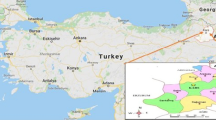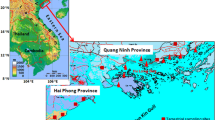Abstract
The activity concentrations of natural (40K) and anthropogenic (137Cs) radionuclides were measured in the 30 most commonly consumed foods in Korea. The average activity-concentrations of 40K and 137Cs were 67 Bq kg−1 and 46 mBq kg−1 fresh weight of food, respectively. The total annual intakes of 40K and 137Cs by humans were 14915 and 3.64 Bq year−1, respectively. The calculated mean annual effective doses from ingestion of the investigated foodstuffs were 92 µSv for 40K and 0.047 µSv for 137Cs. Our results can provide useful background information on radiation protection in Korea, and in other countries as well.

Similar content being viewed by others
References
United Nation Scientific Committee on the Effects of Atomic Radiation (UNSCEAR) (2000) Sources and effects of ionizing radiation (2000) In: UNSCEAR 2000 Report, Annex B: Exposures from Natural Radiation Sources. United Nations, New York
Berglund M, Wieser ME (2011) Isotopic compositions of the elements 2009 (IUPAC Technical Report). Pure Appl Chem 83(2):397–410
Tykva R, Sabol J (1995) Low-level environmental radioactivity sources and evaluation. Technomic Publishing Company Inc, Lancaster
International Atomic Energy Agency (IAEA) (2006) Applicability of monitored natural attenuation at radioactively contaminated sites. Technical Reports Series, Vienna, p 445
Povinec PP, Aoyama M, Biddulph D, Breier R, Buesseler K, Chang CC, Golser R, Hou XL, Ješkovský M, Jull AJT, Kaizer J, Nakano M, Nies H, Palcsu L, Papp L, Pham MK, Steier P, Zhang LY (2013) Cesium, iodine and tritium in NW Pacific waters—a comparison of the Fukushima impact with global fallout. Biogeosciences 10:5481–5496
Rachubik J, Grosicki A (2009) Radiocaesium activity concentrations in Polish food of animal origin and radiation dose assessment for consumers. Bull Vet Inst Pulawy 53:839–843
Bhat R, Gómez-López VM (2014) In: Bhat R, Gómez-López VM (eds) Practical food safety: contemporary issues and future directions. Wiley, New York
Hernández F, Hernández-Armas J, Catalán A, Fernández-Aldecoa JC, Landeras MI (2004) Activity concentrations and mean annual effective dose of foodstuffs on the island of Tenerife, Spain. Radiat Prot Dosim 111(2):205–210
Jibiri NN, Farai IP, Alausa SK (2007) Estimation of annual effective dose due to natural radioactive elements in ingestion of foodstuffs in tin mining area of Jos-Plateau, Nigeria. J Environ Radioact 94:31–40
Landstetter C, Zapletal M, Sinojmeri M, Katzlberger C (2013) Measurements of natural and artificial radionuclides in food samples and water for human consumption in Austria for the calculation of the ingestion dose. J Radioanal Nucl Chem 296:905–908
Patra AC, Mohapatra S, Sahoo SK, Lenka P, Dubey JS, Thakur VK, Kumar AV, Ravi PM, Tripathi RM (2014) Assessment of ingestion dose due to radioactivity in selected food matrices and water near Vizag, India. J Radioanal Nucl Chem 300:903–910
Tufail M, Sabiha-Javied Akhtar N, Akhter J (2010) Assessment of annual effective dose from natural radioactivity intake through wheat grain produced in Faisalabad, Pakistan. J Radioanal Nucl Chem 283:585–590
Choi MS, Lin XJ, Lee SA, Kim W, Kang HD, Doh SH, Kim DS, Lee DM (2008) Daily intakes of naturally occurring radioisotopes in typical Korean foods. J Environ Radioact 99:1319–1323
Wang CJ, Lai SY, Huang CC, Lin YM (1996) Annual intake of 137Cs and 90Sr from ingestion of main foodstuffs in Taiwan. J Health Phys 31(2):185–191
Akhter P, Ashraf N, Mohammad D, Orfi SD, Ahmad N (2003) Nutritional and radiological impact of dietary potassium on the Pakistani population. Food Chem Toxicol 41:531–534
Butkus D, Laučytė I, Ladygienė R (2006) Estimation of effective dose caused by 40K, 90Sr and 137Cs in daily food. J Environ Eng Landsc 2:77–81
Sugiyama H, Terada H, Takahashi M, Iijima I, Isomura K (2007) Contents and daily intakes of gamma-ray emitting nuclides, 90Sr, and 238U using market-basket studies in Japan. J Health Sci 53(1):107–118
Changizi V, Jafarpoor Z, Naseri M (2010) Measurement of 226Ra, 228Ra, 137Cs and 40K in edible parts of two types of leafy vegetables cultivated in Tehran province-Iran and resultant annual ingestion radiation dose. Iran J Radiat Res 8(2):103–110
National Rural Living Science Institute (2001) Food composition table. Sixth revision, Suwon
Korea Centers for Disease Control & Prevention (2012) Korea Health Statistics 2012: Korea National Health and Nutrition Examination Survey (KNHANES V-3)
International Committee of Radiological Protection (1996) Age dependent doses to members of public from intake of radionuclides: compliation of ingestion and inhalation coefficients. ICRP Publication, Ottawa, p 72
Shiraishi K (2005) Dietary intakes of eighteen elements and 40K in eighteen food categories by Japanese subjects. J Radioanal Nucl Chem 266(1):61–69
Alrefae T, Nageswaran TN (2013) Radioactivity of long lived gamma emitters in rice consumed in Kuwait. J Assoc Arab Univ Basic App Sci 13(1):24–27
Asaduzzaman Kh, Khandaker MU, Amin YM, Mahat R (2015) Uptake and distribution of natural radioactivity in rice from soil in north and west part of peninsular Malaysia for the estimation of ingestion dose to man. Ann Nucl Energy 76:85–93
Shanthi G, Maniyan CG, Allan Gnana Raj G, Thampi Thanka Kumaran J (2009) Radioactivity in food crops from high background radiation area in southwest India. Curr Sci 97(9):1331–1335
Coughtrey PJ, Thorne MC (1983) Radionuclide distribution and transport in terrestrial and aquatic ecosystems: a critical review of data, vol 1. Balkema, Rotterdam
Shanthi G, Thmpi Thanka Kumaran J, Allan Gnana Raj G, Maniyan CG (2010) Natural radionuclides in the South Indian foods and their annual dose. Nucl Instrum Methods Phys Res A 619:436–440
Görür FK, Keser R, Akçay N, Dizman S, Okumusoglu NT (2011) Radionuclides and heavy metals concentrations in Turkish market tea. Food Control 22:2065–2070
Venkatesan S, Murugesan S, Senthur Pandian VK, Ganapathy MNK (2005) Impact of sources and doses of potassium on biochemical and greenleaf parameters of tea. Food Chem 90:535–539
Badran HM, Sharshar T, Elnimer T (2003) Levels of 137Cs and 40K in edible parts of some vegetables consumed in Egypt. J Environ Radioact 67:181–190
Harb S (2006) Measurement of the radioactivity of 238U, 226Ra, 210Pb, 228Th, 232Th, 228Ra, 137Cs and 40K in tea using gamma-spectrometry. J Radioanal Nucl Chem 274:63–66
Ministry of Health & Welfare of Korea (MOHW) (2002) 2001 National health and nutrition survey. Report on overview, MOHW, Seoul, Korea
Ministry of Health & Welfare of Korea (MOHW) (2005) 2004 National health and nutrition survey. Report on overview, MOHW, Seoul, Korea
Wang JX, Chen RS, Zhu HD (2000) Studies in China on ingestion and organ content of trace elements of importance in radiological protection. Working paper presented at final RCM-3 of Reference Asian Man Phase 2, Vietnam
Dang HS, Jaiswal DD, Nair S, Pullat VR (2000) Some importsant input data for generating population specific biokinetic parameters of a few selected radionuclides encountered in nuclear fuel cycle—application in internal dosimetry. Working paper presented at final RCM-3 of Reference Asian Man Phase 2, Vietnam
Shiraishi K, Tagami K, Ban-nai T, Yamamoto M, Muramatsu Y, Los IP, Phedosenko GV, Korzun VN, Tsigankov NY, Shegeda II (1997) Daily intakes of 134Cs, 137Cs, 40K, 232Th and 238U in Ukrainian adult males. Health Phys 73:814–819
Fukushima H, Nakayama I (1992) Radioactivity survey of fallout, water, seawater, soil, and food samples in Japan. the 34th proceeding of environmental radioactivity survey. Science and Technology Agency, Tokyo, Japan, pp 39–42
Acknowledgments
We thank all members in the center for environmental radiation and radioactivity assessment and 15 regional monitoring stations for their technical support with sampling and laboratory analyses.
Author information
Authors and Affiliations
Corresponding author
Rights and permissions
About this article
Cite this article
Chae, JS., Kim, TH., Kim, H.J. et al. Estimation of annual effective dose from ingestion of 40K and 137Cs in foods frequently consumed in Korea. J Radioanal Nucl Chem 310, 1069–1075 (2016). https://doi.org/10.1007/s10967-016-4891-5
Received:
Published:
Issue Date:
DOI: https://doi.org/10.1007/s10967-016-4891-5




